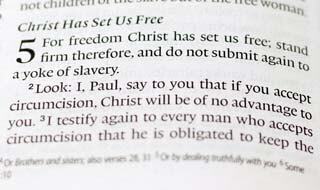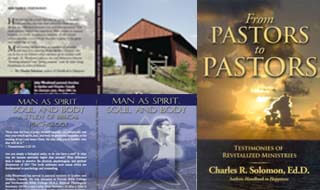“Therefore we were buried with Him through baptism into death, that just as Christ was raised from the dead by the glory of the Father, even so we also should walk in newness of life. For if we have been united together in the likeness of His death, certainly we also shall be in the likeness of His resurrection, knowing this, that our old man was crucified with Him, that the body of sin might be done away with, that we should no longer be slaves of sin” (Rom. 6:4-6 NKJV).
In answer to the question, “Shall we continue in sin that grace may abound?” chapter 6 has four answers. (1) You cannot (verses 1-11); (2) You need not (verses 12-14); (3) You must not (verses 15-19); (4) You had better not (20-23). First Paul reasons with the one who asks the question, then he appeals to him, then he commands him, and finally he warns him! There is reason, “you cannot.” There is appeal, “you need not.” There is command, “you must not.” There is warning, “you had better not!” That is one summary of the chapter…
There are three ruling features in these answers with regard to being free from sin, mentioned in verses 17, 18 and 22. Sin in this chapter should always be with a capital letter, since it is not once mentioned as in the plural. Free from “sins” is not the subject, as in the earlier chapter where justification frees us from sins. It is something further, for it is emancipation from “Sin” as a master, tyrannizing over slaves…
(1) The way in which freedom is secured is given in verses 1-11.
(2) That freedom is to be completely exercised and enjoyed (verses 12-14).
(3) The freedom is not to end in itself, but is a condition of something greater — a condition of holiness and life (15-23).
The method of Deliverance
Let us look particularly at the method of deliverance. There is a parallel in the first eleven verses of Rom. 5 and of Rom 6. In the former we have set forth the implication of Christ’s death for us, but in the latter the implication of our death with Christ….How, then, is freedom affected? By death! Death is the entrance into life, and it is by our own death. Deliverance from sin’s guilt and penalty is possible only by the death of Another for us, but deliverance from the thralldom of sin depends upon our death with Him. The only way of deliverance from sin is by dying to it, for by dying we pass into a realm where sin is not, where the break with it is complete and final.
…That attitude of death is implied and symbolized in baptism. Then we died to sin — how then can we live in it? Sin is hated — not sins, but Sin, the tyrannical master. When we were baptized, did our baptism mean that we died to sin? If not, shall we let it mean that now? It speaks of union with Christ, one-ness, incorporation, association with Him. This union is a complete thing, for it is union with all that He is, in all His relationships. Union with Him in His death, in a clean cut with the old life. Entombment follows. Death and burial are the portals of resurrection, that “even so, we also should walk in newness of life” — new in quality, in nature, in character.
I do not wonder that Paul prayed that he might know the “power of His resurrection” [Phil. 3:10; Eph. 1:19,20]. There is no other power adequate for emancipation from sin, and for a life of holy service. That is the method through which resurrection power works. Get hold of that, and you will avoid disappointment and failure. Newness of life is a sure sequel, if we have died with Christ. Union with Him is a union in all things, right away to its consummation (verse 5). You begin with union with Christ in His death, and once united, you are carried right through into His resurrection. It will not be ours in all its fulness until this physical body is made like His glorified body. Then we shall be in all respects like Him even in body, for the ultimate end of this is a new body. This does not rob us of life in the present, but the “new body” represents the ultimate of the process.
“Our old man was crucified with Him, that the body of sin might be destroyed,” disabled, rendered impotent and inoperative. This body of sin is still a body of sin, even in the case of a believer. Sin’s propensities are in it [“the flesh”]. “Let not sin reign in your mortal body, that ye should obey it in the lusts thereof” (Rom. 6: 12)…
What about the “old man” [who we were in Adam as identified by our unregenerate spirit]? The term seems to be necessitated by the coming into being of the new man. Paul must find a term to describe something that was in him before the “new man” came into being. In Gal. 2: 20, he substitutes for it the capital “I” — “I was crucified with Christ.” We might say the “old man” is the old personality, but it seems an exaggeration, for that means more than you want to say. In this connection Paul uses the word “flesh.”
For years I confused the “old man” and “the flesh”, thinking them to be one and the same. Now I see that to be impossible, for there are two things predicated of the “old man”; (1) “Our old man was crucified with Christ” (Rom. 6: 6); and (2) in the epistles to the Ephesians and the Colossians, the old man [allusion of “old clothes” in Eph. 4:22] is to be “put off.” Indeed, he says, it has been put off [Col. 3:9]. Calvary is the place where the old man was crucified. We ourselves, as well as our sins, were taken there. The old man was executed as a hopeless criminal and rebel [legally and spiritually]…. The task of crucifying the “old man” is not left to us; God has done it, and we have to regard it as already done [“reckon” – v. 11]. But the “flesh” is left for the new man to crucify [radically deny] (Gal. 5: 14). The “old man” is crucified, but his nature, his tendencies, his involuntary habits, remain [“the flesh”]…
…But the death of the slave is but one side of this matter. “For if we died with Christ, we believe that we shall also live with Him.” We share that life now. We need His life ere we can die to sin, and all that sin once meant to us, with Him. We need His life in order to reckon ourselves every day to be dead unto sin. Note again that this is not a dying unto sins, but to sin, that is why it is complete in one act. Dying to “sins” is not complete and final, it is something that goes on day after day. He died — so have we. He lives — so do we. That must be our constant reckoning.
…Every point of the fuller life lies at the Cross.
~~~~~~~~~~~
An excerpt from The Gospel for the Believer, Chapter 2: On Romans ch. 6 – From Sin to Righteousness. The complete chapter is online at http://www.GraceNotebook.com / Classics. Bracketed content added by JBW. See also the GFI Definition of Terms and the contrast of The Old Man and the Flesh: https://gracenotebook.com/the-relationship-between-the-terms-old-man-and-flesh/

















